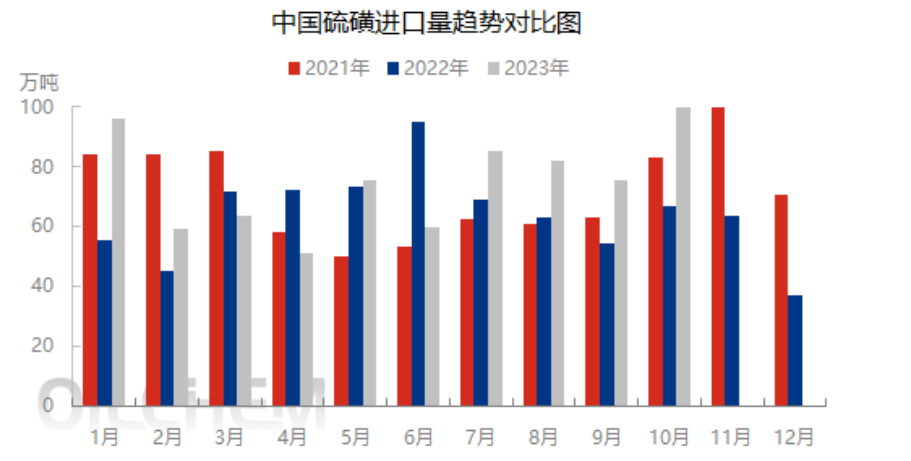According to the data of the General Administration of Customs, China’s sulfur imports in October 2023 were 997,300 tons, an increase of 32.70% from the previous month and 49.14% from the same period last year; From January to October, China’s cumulative sulfur imports reached 7,460,900 tons, up 12.20% year on year. So far, relying on the good advantages accumulated in the first three quarters and the strength of the import data in October, China’s cumulative sulfur imports as of October this year were only 186,400 tons less than the total imports of the whole year last year. In the context of two months of data remaining, China’s total sulfur imports this year will be more than last year, and is expected to reach the level of 2020 and 2021.

As shown in the figure above, except for February, March, April and June this year, China’s monthly sulfur imports in the remaining six months showed varying degrees of growth compared with the same period in the past two years. Especially after the second quarter, the capacity utilization rate of the main downstream phosphate fertilizer industry has recovered and operated at a relatively high level for a period of time, and the improvement of the demand side has boosted the market trading atmosphere and also enhanced the confidence of the industry to wait for the market, so the sulfur import data of the relevant months will have a relatively good performance.
From the perspective of import trading partners, in October 2023, as the main source of China’s sulfur imports in the past, the total import volume was only 303,200 tons, which was 38.30% less than the previous month and only accounted for 30.10% of the import volume in October. The UAE is the only country in the Middle East that ranks third in terms of import data by trading partner. Canada topped the list with 209,600 tons, accounting for 21.01% of China’s sulfur imports in October. The second place is Kazakhstan, with 150,500 tons, accounting for 15.09% of China’s sulfur imports in October; The United Arab Emirates, South Korea and Japan are ranked third through fifth.
In the ranking of China’s cumulative sulfur imports by trading partners from January to October this year, the top three are still only one country in the Middle East, that is, the United Arab Emirates. Top of the list is Canada, from which China imported 1.127 million tons of sulfur, accounting for 15.11% of China’s cumulative sulfur imports from January to October; Second, South Korea imported 972,700 tons, accounting for 13.04% of China’s cumulative sulfur imports from January to October. In fact, in the proportion of imported sulfur in China, the pattern of the reduction of the number of sources from the Middle East was very obvious as early as last year, since the demand of Indonesia opened, its ability to accept high-price resources has absorbed some Middle East resources, in addition to the overall high price of sulfur in the Middle East, domestic merchants have abandoned the previous impulsive relatively rational attitude to the market. And the continuous growth of domestic volume is an important reason for the reduction of sulfur imports from the Middle East in China.
Up to now, the data of Longhong Information shows that the port volume of domestic sulfur import resources in November is roughly 550-650,000 tons (mainly due to the large amount of solid arrivals at southern ports), so the assessment calculates that China’s total sulfur imports from January to November 2023 has a great chance to exceed 8 million tons, even if the domestic sulfur imports in December this year are basically the same as in December 2022. In 2023, China’s total sulfur imports are expected to approach or even exceed 8.5 million tons, so this year in the context of significant domestic increase, the amount of imported resources is also expected to reach the level of 2020, 2021, we may wish to wait and see.
Post time: Nov-30-2023





